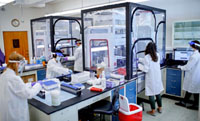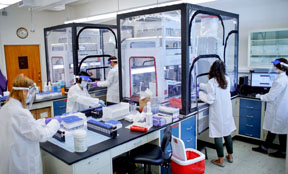
Cornell COVID-19 lab 288

Cornell University photo by Lindsay France
At the heart of a campus-wide COVID-19 surveillance program at Cornell University is a new $1.5 million laboratory dedicated to processing 5,000 to 7,000 samples per day. The lab will operate 12 hours a day, seven days a week.
Upwards of 5,000 tests for the virus that causes COVID-19 are scheduled to be run daily by the Animal Health Diagnostic Center at Cornell University College of Veterinary Medicine starting next week, as the university executes a plan to screen at least once a week all students, faculty and staff who are regularly on campus.
A new unit of the veterinary lab, dubbed the Cornell University COVID-19 Testing Laboratory, was built from scratch within two months this summer in vacant research space in a separate building, said Dr. Diego Diel, the lab director. The facility aims to generate test results within 24 hours.
At the veterinary diagnostic center, Diel directs the virology lab. He and his team were tapped for the COVID-19 testing project because of their expertise in quickly processing thousands of tests for pathogens in farm animals, such as chickens and cattle, as well as in pets, using polymerase chain reaction, or PCR, the same molecular technique used to detect SARS-CoV-2, the virus that causes COVID-19.
Ordinarily at the animal lab, Diel said, "We do probably between 300 to 1,000 samples a day, depending on the day and the time of year. Winters are busier."
The COVID-19 lab will be able to run five times that higher number by pooling the samples: Specimens collected from five individuals will be processed together. If a pool tests positive, the samples it contains will be rerun separately to pinpoint whose sample is infected.
"For low prevalence [of disease], it's a very good approach," Diel said. "As the prevalence increases to levels above 10%, pooling is not recommended because you have to go back and repeat so many pools that it doesn't make sense in terms of efficiency, or for saving supplies and reagents."
Diel said that when the project began about 60 days ago, the lab began ordering enough supplies and reagents "to keep us going for at least two or three months."
The lab began on Aug. 17 to process tests of people returning to Cornell. The program gets underway in earnest once classes begin on Sept. 2.
A rundown of surveillance logistics lists seven test sites on the Ithaca, New York, campus, including at the College of Veterinary Medicine. Undergraduate students must be tested twice a week. Students pursuing graduate and professional degrees must be tested once a week.
Faculty and staff who are on campus an average of two or more days per week also must be tested weekly. Those on campus fewer than two days per average week must be tested every other week.
Since the COVID-19 human pandemic took hold this year, a number of university-based veterinary diagnostic labs have offered to put their equipment and know-how to work on the disease. About 13 veterinary labs around the country are now running human COVID-19 tests, according to Dr. David Zeman, executive director of the American Association of Veterinary Laboratory Diagnosticians.
Labs that handle human samples must be certified under a U.S. Department of Health and Human Services program known as CLIA, which stands for Clinical Laboratory Improvement Amendments. The Cornell COVID-19 lab is operating under the auspices of Cayuga Health System, which has CLIA certification. Cayuga Health System operates two hospitals in upstate New York.
Diel said the Cornell COVID-19 lab has eight full-time staff: five existing lab employees and three new hires. It is in the process of hiring two more workers on a temporary basis.
In addition to human power, the lab uses robotic equipment to handle the repetitive work of pipetting liquid samples into pools for batch processing.
On top of labor savings, Diel said, the advantage of the robots is that they can scan barcodes on each sample, enabling the lab to track the identities of samples in each of the pools.
"It would be a huge amount of time and effort if we were to have to do it manually," Diel said. "I think it would be nearly impossible to do it without the liquid handlers with barcode-scanning capability."
Although the new COVID-19 lab diverts staff from veterinary work, Diel said the animal health lab's capacity for veterinary diagnostics is undiminished. "We had redundancies here in the diagnostic lab and basically, the equipment that is needed for this COVID testing was purchased brand new, so the animal diagnostic capability will remain the same," he said.
The Cornell veterinary diagnostic lab is able to detect SARS-CoV-2 in samples from veterinary patients, as well. It was involved this spring in finding the virus in a tiger at the Bronx Zoo, in what became the first documented case of COVID-19 in a nonhuman patient in the United States.
Overall, on the veterinary side, the lab has done COVID-19 testing on just "a handful of samples so far from different animal species," Diel said.
On the human side, as test results become available, Cornell University will post reports on a dashboard that includes information on the number of new positive cases by day, by week and since tracking began; on-campus capacity for quarantine and isolation; and hospital and surveillance testing capacity.
The dashboard communicates the current alert level, of which there are four, color-coded from green to red. Green indicates "new normal," and means that cases are rare and transmission is controlled. Red signifies a campus shutdown.
Today, the alert status is green.